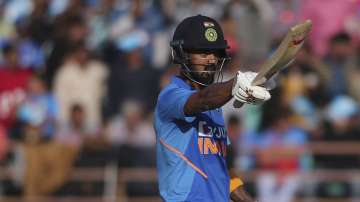Is KL Rahul India's long-term option for wicketkeeper-batsman in limited-overs?
KL Rahul passed is first test with flying colours in Rajkot when he scored a 52-ball 80 at No.5 and kept well to the spinners as well.

Irrespective of what the results might turn out to be at the M Chinnaswamy Stadium on Sunday, KL Rahul and his "multi-dimensional"- ity will be the biggest talking point and the biggest positive from the series. The contest against Australia at home had started out with talks about Rahul versus Shikhar Dhawan over who would partner Rohit Sharma at the top of the batting order. By the end of the second ODI, the only debate that withstood after India's impressive 36-run win in Rajkot was - should India consider the 25-year-old as a long-term option for the role of wicketkeeper-batsman in limited-overs cricket?
Unable to come to a clear conclusion, Virat Kohli sacrificed his No.3 spot to fit the trio in for the opener. After the failed ploy, Kohli returned to his preferred spot and Rahul was shifted down to No.5 for the second ODI. Rahul returned with a 52-ball 80 laced with exquisite and innovative strokeplay that helped India set up a massive 340-run target in Rajkot. And unintentionally though, India seemed to have solved not their debate over their second-opening batsman, but also their middle-order issues. But there was a fresh discussion that took shape along with India's series-levelling win which pertained to Rahul's wicketkeeping.
For quite some months now, there has been a certain whisper from veterans and analysts over considering Rahul as a back-up wicketkeeping option (in T20Is) amid Rishabh Pant's faltering form in limited-overs cricket.
India had called-up Sanju Samson during the Bangladesh T20I contest last year, and the Sri Lanka series in January, and was given only one opportunity before being dropped for the crucial New Zealand series. Amid these puzzling selections, many had popped the idea of trying Rahul as a wicketkeeper given his impressive and consistent form in both ODIs and T20Is.
Before January 2020, Rahul never played the role of a wicketkeeper for India in any format. Although he did serve as wicketkeeper-batsman for Royal Challengers Bangalore for a few years. But on Tuesday (January 14), Rahul had to don the gloves after first-choice keeper Pant incurred a concussion while batting in the first ODI against Australia and was retained for the role after the youngster failed to recover for the second ODI.
While Rahul's role seemed insignificant in the opener where David Warner and Aaron Finch toyed with the Indian attack, stitching a record-breaking 258-run opening stand, the 25-year-old hogged all the limelight in India's Rajkot comeback. He affected a superb, or to be precise, a light-quick stumping to dismiss the Aussie skipper off Ravindra Jadeja and also grabbed two catches in the second ODI. And, was more than decent against the spinners Kuldeep Yadav and Ravindra Jadeja although he did express that it was difficult to read him.
Rahul, hence, proved to be a complete package in the second ODI - a middle-order batsman who can hold the momentum and accelerate the run rate in the slog overs and can keep as well. So should India look at Rahul, instead of Pant, as their wicketkeeper in limited-overs cricket?
THE GOOD
Rahul has been in a stellar form in limited-overs cricket since World Cup 2019 where he had scored a century. Since November 2019, he has batted 13 times in the two formats and amassed 650 runs at a strike rate of 116.27, which includes a one-day century against West Indies and six other half-centuries at an average of 54.16. Overall in his career, Rahul had batted on eight other instances at No. 4 or lower in one-dayers, including domestic List A matches, but had never scored a fifty in them, until Friday.
India cannot leave out such an option from the batting lineup - ODIs or T20Is. This implies, with the top-three settled as usual, there will be a toss-up between Shreyas Iyer and Rahul for the No.4 and 5 spots depending on the match situation.
Now, India can opt for Pant as a No.6 option with Hardik Pandya as the sole all-rounder, leaving India with five-bowling option.
But if India opt for Rahul as their wicketkeeper, the management can fit in two all-rounders in Pandya and Jadeja, leaving the lineup with six bowling options - the plan most suitable for overseas matches.
THE BAD
Well, the very question and the brewing discussion over Rahul as a primary option might just be too soon. It has just been two innings where Rahul took over the responsibility. While he did fare well, the management, in all possibility, will look at Pant as their sole option. But in Rahul, they did find a handy back-up option.
Moreover, while the idea may be good for T20Is, where wicketkeepers do not play a very significant role, in ODIs, they do need a bit of a specialist.
THE UGLY
Pant is likely to come back for the third and final ODI game of the series against Australia. It will hence be worth watching on how India will frame their playing XI on the belter in Bengaluru.